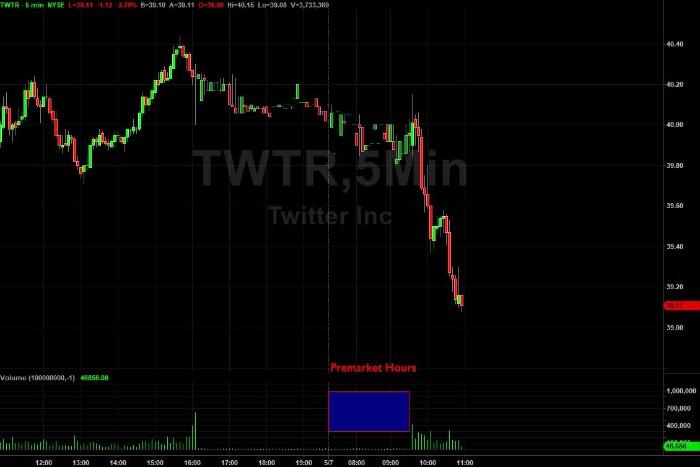Investing in the stock market has changed dramatically over the last few decades, as have trading activities. Nowadays, a trader can buy or sell securities in two main ways: pre-market and after-hours trading. Each type offers advantages and disadvantages, but understanding these differences is crucial for maximum investment returns.
In this blog post, we'll explore the significant difference between pre-market and after-hours trading activities to help you make more informed decisions about investing your hard-earned savings. So read on if you want to fully understand what goes into each type of activity before deciding which one works best for meeting your financial goals.
Overview of Pre-Market and After-Hours Trading Activities
Pre-market and after-hours trading activities refer to buying and selling stock securities outside regular trading hours. While traditional markets are open from 9:30 a.m. to 4 p.m., pre-market and after-hours trading occur before and after. This trading activity can provide investors with flexibility and the potential to capitalize on market developments outside regular trading hours.
However, it is important to note that pre-market and after-hours trading has unique risks that investors must be aware of before engaging in such activities.
For example, more liquidity may be needed as many traders need to actively participate in the market. Moreover, there is an increased risk of price manipulation as investors may need help accurately assessing true market value due to a lack of information and volume during these times.
Understanding the Different Types of Trades

Pre-market and after-hours trading activities are two types of stock trades that occur outside the normal hours of 9:30 a.m. to 4:00 p.m., known as the regular trading session for stocks on U.S. exchanges such as the New York Stock Exchange (NYSE).
The term “pre-market” refers to trading activities before the opening bell and after the close of regular trading hours. During this time, stock orders can be entered and executed but are not included in the official end-of-day closing price. On the other hand, after-hours trades occur after the market has closed for the day and are typically made through electronic communication networks or market makers.
Pre-market trading activities generally have less liquidity and higher volatility than during the regular session due to fewer participants. The same is true for after-hours trades, which can often be subject to wide bid/ask spreads, making it difficult to execute orders quickly and accurately. Therefore, investors should exercise caution when engaging in pre-market or after-hours trading activities.
In addition, regulations governing pre-market and after-hours trading may vary from exchange to exchange, so investors need to be aware of the rules and guidelines for each particular market they are transacting in.
Benefits and Risks of Pre-Market & After-Hours Trading
Pre-market and after-hours trading activities allow investors to quickly speculate on market movements or react to the news. In some cases, these activities provide advantages that are not available during standard market hours. However, all investors should know the risks associated with pre-market and after-hours trading before engaging in these activities.
The main benefit of pre-market and after-hours trading is the potential to react quickly to news events or market movements outside standard trading hours. For example, suppose a company announces earnings before the markets open. In that case, investors participating in pre-market trading can take advantage of the resulting price movements. Similarly, after-hours trading allows investors to react quickly to news events or market movements during non-trading hours.
Despite the potential advantages of pre-market and after-hours trading activities, several risks are also associated. It can be difficult to obtain accurate pricing information due to the relatively low trading volume during these hours. In addition, there is always a risk of liquidity problems since fewer buyers and sellers participate in pre-market and after-hours trading activities than during standard market hours.
Finally, investors should know the potential legal risks associated with pre-market and after-hours trading activities. Before engaging in these activities, investors should familiarize themselves with the terms and conditions of their brokerage accounts to ensure they are not engaging in any illegal activity.
Analyzing Company and Market Information Before Trading

Before getting into any pre-market or after-hours trading activities, it is important to do your due diligence and analyze the company and market information. Doing so will help ensure that you are investing in companies with the potential to increase in value. It can also provide valuable insight into how the current market conditions affect investment decisions.
When analyzing company and market information, some important aspects include the company's historical performance, current financial position, management team, industry trends, macroeconomic factors, and other relevant news. Additionally, it would be best to consider upcoming events, such as earnings reports or corporate announcements, that may impact a company's stock price.
By researching all this information, you can better understand the company and be better equipped to make informed decisions about pre-market and after-hours trading activities.
FAQs
What happens during pre-market hours?
Pre-market trading takes place before the regular market opens. It occurs between 4:00 a.m. and 9:30 a.m. EST, Monday through Friday, and is only available for certain stocks. During this time, investors can execute buy and sell orders before the regular markets open to capitalize on the news or other events that may affect the price of a stock.
What happens during after-hours trading?
After-hours trading is similar to pre-market trading but occurs after the regular market closes (usually between 4:00 p.m. and 8:00 p.m., Monday through Friday). This allows investors to react to news or events after the regular markets are closed.
What trades can be done during pre-market and after-hours trading?
During pre-market and after-hours trading, investors can execute different orders, including market orders, limit orders, stop loss orders, trailing stop orders, and more. It is important to understand the risks of each type of order before executing them.
Conclusion
With the right knowledge and an understanding of how trading works outside regular market hours, investors can benefit from Pre-Market and After-Hours Trading Activities. It's important to remember that these extended trading sessions come with heightened risk and potentially big rewards.
By thoroughly researching company information, predicting stock performance, and using online trading tools, traders can increase their chances for success.




